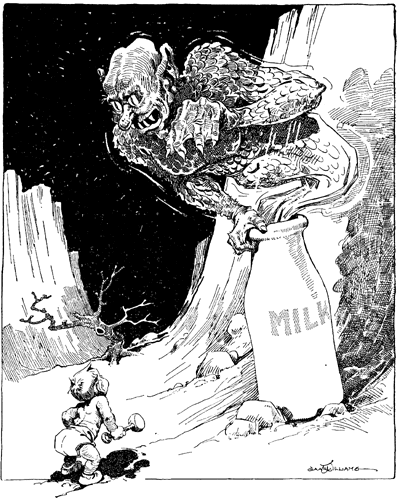Early in his administration at the Indiana State Board of Health, Dr. John Hurty took on the fight for healthy milk. As the cartoon and caption on this page suggest, children were the most frequent victims of impure milk.
Hurty had the law behind him to fight against bad milk, but he lacked money and staff to enforce it. His recommendations for costly pasteurization and bottling of milk brought protests from many dairymen. Hurty and others urged that pasteurization of milk be carried out at home to kill germs (Rice, 162, 167).
The State Board of Health had the power to close dairies and did so. Sometimes the sanitary conditions at the dairy--not the adulteration of milk--caused the closure. In a paper presented at a conference of health officers in June 1899, Dr. A. W. Bitting, Purdue University outlined four inspection elements:
A complete milk and dairy inspection . . . the milk as to quality . . . the presence of adulterants . . . the examination of the cattle for diseases . . . and of the surroundings (ISBH, Annual Report, 1899, p. 185).
In addition to assuring purity of milk at the start of the supply line, delivery steps also needed to be controlled. According to Rice (161),
The milkman in the city distributed milk from door to door, dipping it from an open can--and sometimes drinking from the dipper himself . . . . The milk was left on the doorstep in a pan of some sort. If the pan was not taken in promptly it is likely that the cat might beat the housewife to it.
An April 1900 Bulletin of the State Board of Health, mentions "sticks, hairs, insects, blood, pus and filth in milk. The same Bulletin says that by careful measurement the citizens of Indianapolis consume over one ton of manure in a year's time" in milk (Rice, 162).
The most serious adulteration of milk--especially for children--was the use of formaldehyde as a preservative. As early as July 1899, the Indianapolis News reported prosecutions of dairymen who added formaldehyde to milk. Many children--including infants at the Indianapolis Orphans Home--died from contaminated milk (Ibid., 164).
Regardless of prosecutions, better knowledge, and the cooperation of many dairymen who wanted pure milk, the fight went on for many years (Ibid., 168). By 1909, however, dairymen and health officers were carrying out their second annual convention "To Study Sanitary Milk Production and Distribution . . ." (Convention Program).

According to Rice (161) "in 1896 it was a very serious matter indeed if a mother could not nurse her own child. . . . few such children even lived to adult life. . . . The biggest reason for all this was . . . the very poor quality of the milk which was available for baby feeding and for use by the public in general." This cartoon by Gaar Williams visualizing the situation appeared in the Indianapolis News (date unknown, circa 1900). The caption reads, "It looks like a tough battle for the little fellow" (Rice, 163). Williams was a famous Hoosier cartoonist.
